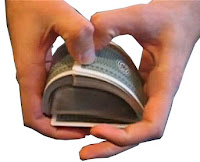Thursday, February 28, 2013
First Govett-Brewster director slams Len Lye Centre
Posted by
jim and Mary
at
4:30 PM
![]()
![]()
Labels: controversy, govett-brewster, len lye centre
That was the year that was
Posted by
jim and Mary
at
12:00 PM
![]()
![]()
Labels: 55 years on
One of our Senators is missing.
Posted by
jim and Mary
at
6:57 AM
![]()
![]()
Labels: dealer gallery, fomison, lookalike
Wednesday, February 27, 2013
In the shadows
We’ve mentioned the interests of the current Minister of Arts Culture and Heritage often enough so, post Labour's Shadow Cabinet shuffle, here’s a look at their new line up art-wise. The good news is that both the Shadow spokesperson (Grant Robertson who has often been tipped as a potential PM) and one of the Associates are ranked high. Grant Robinson is number 2 as Deputy leader and the Associate Jacinda Ardern is ranked at 4. The other Associate is Darien Fenton who is ranked at 16. So far as interests go Robertson is positioned in his Labour Party profile as “a keen sports fan, particularly cricket, rugby and the mighty Wellington Phoenix. He is also a fan of New Zealand music and literature, and loves cooking and movies.” Fenton and Ardern’s Labour Party profiles makes no mention of the arts at all although Fenton was once a music teacher and claims some early experience with film. As to the Labour Party's arts policy – well you try and find it on their website we couldn’t. But here it is on The Big Idea. Thanks CNZ.
Posted by
jim and Mary
at
6:47 AM
![]()
![]()
Labels: arts policy, minister arts
Tuesday, February 26, 2013
Crafty
Posted by
jim and Mary
at
12:00 PM
![]()
![]()
Labels: copycat, dealer gallery
Googling on: paint by numbers
Posted by
jim and Mary
at
6:30 AM
![]()
![]()
Labels: auckland art gallery, exhibitions, hirst, mccarthy, warhol
Monday, February 25, 2013
Ralph Hotere 1931-2013
SWOT
Posted by
jim and Mary
at
7:00 AM
![]()
![]()
Labels: dealer gallery, dealers, venice biennale
Saturday, February 23, 2013
Saturday at the movies
It’s Saturday morning so why not settle back and watch this clip from the US TV show Portlandia taking a friendly pot shot at conceptual art.
Posted by
jim and Mary
at
7:00 AM
![]()
![]()
Labels: art in the movies
Friday, February 22, 2013
Adze break
Posted by
jim and Mary
at
6:54 AM
![]()
![]()
Labels: artist studio, sculpture
Thursday, February 21, 2013
The difference engine
Posted by
jim and Mary
at
12:00 PM
![]()
![]()
Labels: art museum, by the numbers
Abstracts
Wednesday, February 20, 2013
Good work
Posted by
jim and Mary
at
12:00 PM
![]()
![]()
Labels: christchurch art gallery, cnz venice, curators, venice biennale
Buying up small
COMMENT: Andrew Paul Wood: It is particularly interesting that Ian Scott's lattices coincide with the period that Petar Velutic was his dealer. Before and after it's pop, pretty girls and ironic references to art history.
Posted by
jim and Mary
at
7:00 AM
![]()
![]()
Labels: advice to collectors, auction, collecting
Tuesday, February 19, 2013
Two’s company
Posted by
jim and Mary
at
7:00 AM
![]()
![]()
Labels: art in the movies, photography
Monday, February 18, 2013
What’s the deal here?
Posted by
jim and Mary
at
7:00 AM
![]()
![]()
Labels: dealer gallery, dealers
Saturday, February 16, 2013
Putting the life back into life drawing
Posted by
jim and Mary
at
7:34 AM
![]()
![]()
Labels: art school, drawing
Friday, February 15, 2013
Before Avatar there was Tretchikoff
Posted by
jim and Mary
at
12:00 PM
![]()
![]()
Labels: advice to models, painting
Token sculpture
Posted by
jim and Mary
at
7:00 AM
![]()
![]()
Labels: not animal art, sculpture
Thursday, February 14, 2013
Our promise to you
Posted by
jim and Mary
at
6:40 AM
![]()
![]()
Labels: adam, auckland art gallery, city gallery, dowse, dunedin public art gallery, etc, govett-brewster, Te papa
Wednesday, February 13, 2013
Popes
Posted by
jim and Mary
at
12:00 PM
![]()
![]()
Labels: controversy, pope
Underground art
Posted by
jim and Mary
at
6:50 AM
![]()
![]()
Labels: Art is where you find it
Tuesday, February 12, 2013
Head turner
Posted by
jim and Mary
at
12:00 PM
![]()
![]()
Labels: art in the movies
Breathless
It's made for TV.
This week we discover that Tony the guy who starred in the hit show Queensland before Chris got the part is taking one of the core cast with him which means that Chris will have to find a replacement and a few non-core-cast people are saying that he might take someone from the long runninhg show Auckland that he was in before jumping the ditch. That would mean finding a new star for Auckland which would certainly shake up the current plot lines. Then it turns out that Tony also grabbed Max who was the star of Monash so now that show is searching for a new star to play the Director role at exactly the same time as rival show Ian Potter is also casting a Director character for its own show! Can you believe it? And if any of you thought after last night's episode that Victoria was going to be tempted across the Tasman to take up the starring role in Auckland you can forget it. She has just been picked to lead the cast in the independent production TarraWarra and Juliana, who has worked alonside a lot of NZ players over the years, and who might have been persuaded to join the cast of Auckland has been booked for a reality show sometime next year with the working title Oh Sydney.
We'll return to our regular programming tomorrow. (In the meantime thanks C)
Posted by
jim and Mary
at
6:36 AM
![]()
![]()
Labels: auckland art gallery
Monday, February 11, 2013
Gloomy bears
“I have tried to come up with a selection that feels good, or conveys a sense of joy. It is an antidote, perhaps, to the gloominess associated with New Zealand art…”
Posted by
jim and Mary
at
12:00 PM
![]()
![]()
Labels: doom and gloom, minister arts, quote
The name game.
Jenny Harper
Paula Savage
Rhana Devenport
NOTE: These survey results are subject to the usual margin of error associated with gossip and hearsay.
Posted by
jim and Mary
at
7:00 AM
![]()
![]()
Labels: auckland art gallery
Saturday, February 09, 2013
The ping and the pong of it.
Artists Doug Fridlund and Mikael Alcock got to be Youtube celebs just by making their art. And their art it turns out involves putting ping-pong balls in their mouths and standing next to famous paintings in high end museums like the Tate. No sooner do they start a ping-pong-performance than the cameras are out and the images start piling up on Twitter and Facebook. Ping Pong, art and photographing in art museums. It all adds up to an OTN Saturday movie time special.
Posted by
jim and Mary
at
7:00 AM
![]()
![]()
Labels: performance, ping pong
Friday, February 08, 2013
Branded (doubly whammy edition): Regan Gentry and Andrew Barber
Posted by
jim and Mary
at
12:00 PM
![]()
![]()
Labels: artist brands, Branded
Vanishing point
Posted by
jim and Mary
at
7:00 AM
![]()
![]()
Labels: auckland art gallery, dealers, online












































